Thomas Eakins
 From Conservapedia
From Conservapedia Thomas Eakins (1844-1916) was an American painter who concentrated in the subject of realism, and the first great painter in the period after the American Civil War. His masterpiece, The Gross Clinic, was recently sold for a staggering $68,000,000, the highest price paid for an American portrait, despite being critically rejected by his contemporaries during the time it was created.
Contents
Early life[edit]
Except for a period of study in Europe and a trip to the western United States, Eakins lived his entire life in Philadelphia, Pennsylvania. Here he learned manual dexterity and precision from his father, a master of the art of writing and calligraphy. He had a sound education, doing well in his studies, especially math and the sciences. His interest in art led him to enroll in the Philadelphia Academy of Fine Arts, where he developed his knowledge of the live model by attending medical lectures in anatomy at the nearby Jefferson Medical College, witnessing operations and dissections by Doctor Samuel Gross, one of the 19th century's brilliant American surgeons.
To further his studies in art, he went to France in 1866 and enrolled in the École des Beaux-Arts for three years, then going to Spain in 1869, where his studies were influenced by the 17th century paintings of Diego Velazquez, José de Ribera, and especially the Dutch painter Rembrandt. Rejecting the European impressionists, he preferred those who created a bold sense of life and applied that to his own, working in the oil medium.
Return to Philadelphia[edit]
By 1870 Eakins was back in Philadelphia, creating his first portraits from his family members and those of his fiancée, Katherine Crowell. These portraits were domestic settings, involving children at play or pets, employing an exactness of color, expression, and mood. From there he would paint outdoor life and sports with a candid realism; his Max Schmitt in a Single Scull was a mastery of perspective, of light and shadow, and color and composition.
The Gross Clinic[edit]
In 1875 Eakins embarked on a painting intended for the Centennial Exposition in Philadelphia, and as his subject he returned to Jefferson Medical College where he sat and observed the teaching of Dr. Gross. The result was a large painting, The Gross Clinic, which showed Gross standing before his students in a moment of explanation, the bloody scalpel in his hand fresh from opening an incision for his assistants, while the patient's mother flings an arm before her face to shield herself from the scene, her emotions in sharp contrast to the patience displayed by Dr. Gross.
The public and press responded to The Gross Clinic unfavorably, and Eakins was forced to display it in a medical section of the Exposition, rather than the actual art exhibition; eventually it would reside nearly forgotten in the Jefferson Medical College for years. Eakins was dismayed that the frank realism displayed in The Gross Clinic represented pain and suffering, according to the critics, and could not be called entertaining, as paintings were assumed to be during that time.
Later period[edit]
In the late 1870s Eakins was teaching at the Pennsylvania Academy of Fine Arts, concentrating on drawing and painting. In a departure from Victorian norms, he removed the practice of drawing and painting from antique sculptures and replaced them with live nude models. Unfortunately, Eakins could not convince many outside his classroom walls that painting from nudes was innocent in practice, and he was forced to resign from the Academy in 1886.
Paintings[edit]
- Street Scene in Seville 1870, Mrs. John R. Garrett, Sr. Collection
- Home Scene 1871, Brooklyn Museum, New York
- Max Schmitt in a Single Scull 1871, Metropolitan Museum of Art, New York City
- Katherine 1872, Yale University Art Gallery, New Haven, Connecticut
- The Pair-Oared Shell 1872, Philadelphia Museum of Art
- The Biglin Brothers Turning the Stake 1873, Cleveland Museum of Art, Cleveland, Ohio
- John Biglin in a Single Scull 1873, Metropolitan Museum of Art, New York City
- Sailing 1874, Philadelphia Museum of Art
- Pushing for Rail 1874, Metropolitan Museum of Art
- The Gross Clinic 1875, Philadelphia Museum of Art and the Pennsylvania Academy of Fine Arts (joint display)
- Will Schuster and Blackman Going Shooting 1876, Yale University Art Gallery
- Chess Players 1876, Metropolitan Museum of Art
- William Rush Carving His Allegorical Figure of the Schuylkill River 1877, Philadelphia Museum of Art
- The Fairman Rogers Four-in-Hand 1879, Philadelphia Museum of Art
- The Crucifixion 1880, Philadelphia Museum of Art
- Mending the Net 1881, Philadelphia Museum of Art
- Singing a Pathetic Song 1881, Corcoran Gallery of Art, Washington, D.C.
- The Writing Master 1882, Metropolitan Museum of Art
- The Swimming Hole 1883, Fort Worth Art Center Museum, Fort Worth, Texas
- Lady with a Setter Dog 1885, Metropolitan Museum of Art
- Walt Whitman 1887, Pennsylvania Academy of the Fine Arts, Philadelphia
- Letitia Wilson Jordan Bacon 1888, Brooklyn Museum, New York City
- Miss Van Buren 1889, Phillips Collection, Washington, D.C.
- The Agnew Clinic 1889, University of Pennsylvania, Philadelphia
- Professor Henry A. Rowland 1891, Addison Gallery of American Art, Andover, Massachusetts
- The Concert Singer 1892, Philadelphia Museum of Art
- Frank Hamilton Cushing 1894–95, Thomas Gilcrease Institute of American History and Art, Tulsa, OK
- Taking the Count 1898, Yale University Art Gallery
- Salutat 1898, Addison Gallery of American Art
- Between Rounds 1899, Philadelphia Museum of Art
- Benjamin Eakins 1899, Philadelphia Museum of Art
- Mrs. William D. Frishmuth 1900, Philadelphia Museum of Art
- The Thinker: Louis N. Kenton 1900, Metropolitan Museum of Art
- Self-Portrait 1902, National Academy of Design, New York City
- Mrs. Edith Mahon 1904, Smith College Museum of Art, Northampton, Massachusetts
- Monsignor Diomede Falconio 1905, National Gallery of Art, Washington, D.C.
References[edit]
- Sewell, Darrel. Thomas Eakins, Yale University Press, New Haven, Connecticut (2001)
- Homer, William Innes. Thomas Eakins: His Life and Art, Abbeville Press, New York (1992)
- Foster, Kathleen A. Thomas Eakins Rediscovered: Charles Bregler`s Thomas Eakins Collection at the Pennsylvania Academy of the Fine Arts, Yale University Press, New Haven, Connecticut (1998)
External links[edit]
Categories: [American Painters] [American Portrait Painters]
↧ Download as ZWI file | Last modified: 02/08/2023 07:54:06 | 8 views
☰ Source: https://www.conservapedia.com/Thomas_Eakins | License: CC BY-SA 3.0
 ZWI signed:
ZWI signed: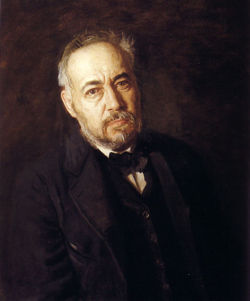

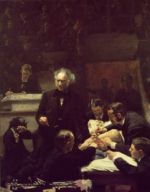
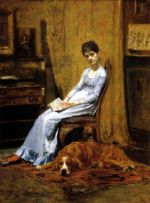
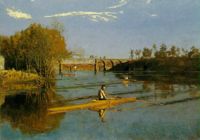
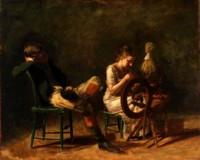
 KSF
KSF